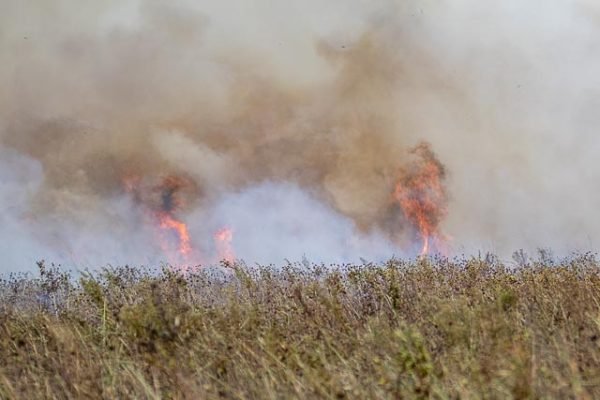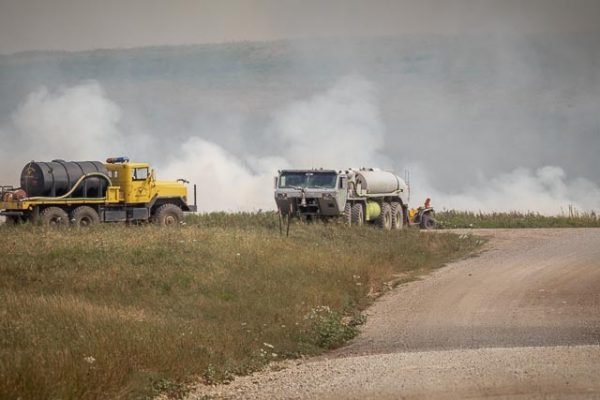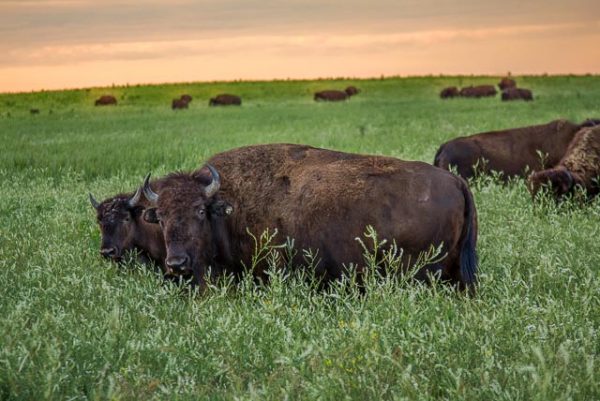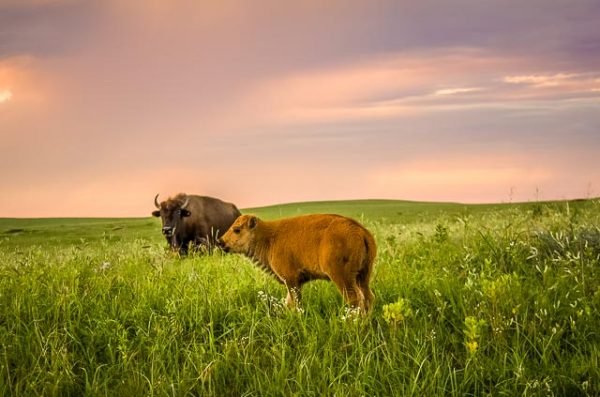Tallgrass Prairie Preserve

The Joseph H. Williams Tallgrass Prairie Preserve is the largest (39,650 acres) protected remnant of tallgrass prairie left on earth. Due to urban sprawl and conversion to cropland, this ecoregion, originally spanning across 14 states from Texas to Minnesota, have left less than 4% remaining of this magnificent landscape.
Since 1989, The Nature Conservancy in Oklahoma has proven successful at restoring this fully-functioning portion of the tallgrass prairie ecosystem with the use of 2,500 free-ranging bison and a “patch-burn” model approach to prescribed burning.
The preserve is located at the southern end of the Flint Hills, a rocky, rolling prairie that stretches from northern Kansas into Oklahoma. Exposed limestone formations make cultivation difficult, and thus the Flint Hills have survived much as they were when they were an Indian hunting ground for tribes such as the Wichita, Osage, and Kaw. In March bison graze the new green grass in areas of the preserve which were burned the previous fall.
Prior to its purchase by the Nature Conservancy in 1989, the preserve was called the Barnard Ranch which had been part of the Chapman-Barnard ranch of 100,000 acres. The foreman of the Chapman-Barnard ranch, Ben Johnson, Sr. was a rodeo champion. His son, also a rodeo champion, was Ben Johnson, Jr. who appeared in more than 300 movies and won an Oscar for his role in The Last Picture Show.
The preserve is bisected by well-timbered Salt Creek and its tributaries. The eastern portion of the preserve is in the Cross Timbers, a north-south running belt of tangled oak forests that were a major impediment to early travelers heading west. About 10 percent of the preserve is forested and the remainder is tallgrass prairie with grasses of several species that can grow 10 feet tall.
The tallgrass prairie owes its existence to fire, whether caused by lightning or manmade. Without fire, the prairie quickly becomes brushland. The Indians were aware of this and burned the prairie regularly to nurture new growth of succulent grasses and to kill intrusive trees and shrubs. The Nature Conservancy has continued this practice with a process called “patch burning” in which about one-third of the prairie is burned each year. This process has proven beneficial not only for bison and cattle, but also for the threatened greater prairie chickens which also inhabit the preserve in small numbers.
What to Photograph
Drive the scenic 10-mile bison loop. Explore the hiking trail and scenic turnouts. Experience wildlife such as birds, butterflies, deer, and bison. Enjoy a picnic and visit the gift shop.
The principal activity for the 10,000 visitors to the preserve yearly is driving the many dirt roads to observe the bison. It is a rare visitor who does not see hundreds of bison near – and often blocking – the roads. The herd now numbers more than 2,500 and grazes 21,000 acres of mostly open range. Bison are rounded up each fall and the excess numbers sold. There are scenic turnouts along the roads and broad vistas of rolling prairie, emerald green in spring, tall and brown in fall, and dotted with wildflowers in the summer.
The prairie puts on a different show for every season and each has its own unique beauty:
Spring/Summer:
By mid-May, 600-700 bison calves are frolicking the prairie.
Mid‑May through mid‑June, wildflowers cover the fields with blankets of color. Though wildflowers bloom throughout the warm months, they peak in spring, with another fine showing late summer.
Prairie chickens boom at sunrise from late March through early May.
During the warm months, migrating neotropical species, such as the Dickcissel and Scissor‑tailed flycatcher, are seen frequently.
Signature grasses such as big bluestem and switchgrass appear in April, begin producing seed in late July, and continue to grow through September.
Fall/Winter:
By September the big bluestem and switchgrass reach heights of 6 to 8 feet with a few patches stretching to 10 feet. When trees turn to their rich autumn colors, so do the grasses.
Rough‑legged and Red‑tailed Hawks, Northern Harriers and both Bald and Golden Eagles are common sights during the fall and winter. You also may see deer, coyotes or bobcats roaming the prairie.
Where it is:
Directions to the Preserve: From downtown Pawhuska, drive north on Kiheka at the intersection of Highway 60 (at the corner of the triangle-shaped building), follow signs to the Preserve headquarters (approx. 18 miles).
Maps:
Interactive Google Map
Use the map + – controls to zoom in and out, click and drag the to move the map, use the Map drop-down to change to “Map”, “Satellite”, “Hybrid”, or “Terrain” views. Drag the little man icon from the upper left corner to a map location for street level view.
GPS:
36°44’29.22″ N 96°21’49.901″ W
Hours:
Cost:
There is no admission cost for the Tall Grass Prairie Preserve.
Facilities:
The headquarters of the Chapman-Barnard ranch has been converted into a visitor center with restrooms, a gift shop, and the restored bunkhouse in which the cowboys lived. The main building is listed in the National Register of Historic Places. The gift shop is open from 10 a.m. to 4 p.m from March to mid-November. Public Restrooms are available at the visitor center.
Location Contact Information:
Joseph H. Williams Tallgrass Prairie Preserve
Tallgrass Prairie Preserve Photo Gallery
Click Here for full page gallery
More Photographic Destinations in Oklahoma:
Interactive Google Map
Use the map + – controls to zoom in and out, use the Map drop-down to change to “Map”, “Satellite”, “Hybrid”, or “Terrain” views. Drag the little man icon from the upper left corner to a map location for street level view. Click on a pushpin for more information about the Photographic Destination, then click on the title to go to the location page.
Click Here for Photographic Destinations by State










Thanks Greg! Hopefully we can stop there on our way to Sedona next March. Your photos of the buffalo are great in the tall grass. I am glad there is some left. I understand the roots go very deep so the grass can survive in a drought.